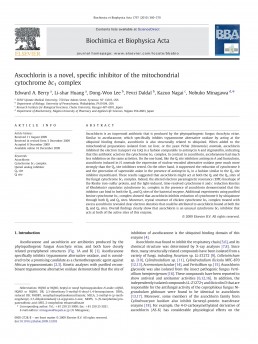Click the link above for more details.
Ascochlorin is a novel, specific inhibitor of the mitochondrial cytochrome bc1 complex
Abstract
Ascochlorin is an isoprenoid antibiotic that is produced by the phytopathogenic fungus Ascochyta viciae. Similar to ascofuranone, which specifically inhibits trypanosome alternative oxidase by acting at the ubiquinol binding domain, ascochlorin is also structurally related to ubiquinol. When added to the mitochondrial preparations isolated from rat liver, or the yeast Pichia (Hansenula) anomala, ascochlorin inhibited the electron transport via CoQ in a fashion comparable to antimycin A and stigmatellin, indicating that this antibiotic acted on the cytochrome bc1 complex. In contrast to ascochlorin, ascofuranone had much less inhibition on the same activities. On the one hand, like the Qi site inhibitors antimycin A and funiculosin, ascochlorin induced in H. anomala the expression of nuclear-encoded alternative oxidase gene much more strongly than the Qo site inhibitors tested. On the other hand, it suppressed the reduction of cytochrome b and the generation of superoxide anion in the presence of antimycin A3 in a fashion similar to the Qo site inhibitor myxothiazol. These results suggested that ascochlorin might act at both the Qi and the Qo sites of the fungal cytochrome bc1 complex. Indeed, the altered electron paramagnetic resonance (EPR) lineshape of the Rieske iron–sulfur protein, and the light-induced, time-resolved cytochrome b and c reduction kinetics of Rhodobacter capsulatus cytochrome bc1 complex in the presence of ascochlorin demonstrated that this inhibitor can bind to both the Qo and Qi sites of the bacterial enzyme. Additional experiments using purified bovine cytochrome bc1 complex showed that ascochlorin inhibits reduction of cytochrome b by ubiquinone through both Qi and Qo sites. Moreover, crystal structure of chicken cytochrome bc1 complex treated with excess ascochlorin revealed clear electron densities that could be attributed to ascochlorin bound at both the Qi and Qo sites. Overall findings clearly show that ascochlorin is an unusual cytochrome bc1 inhibitor that acts at both of the active sites of this enzyme.
CategoryPeer-reviewed PublicationsDate2009.12Linkwww.ncbi.nlm.nih.gov
